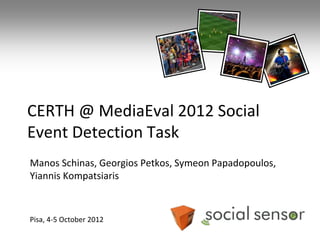CERTH @ MediaEval 2012 Social Event Detection Task
- 1. CERTH @ MediaEval 2012 Social Event Detection Task Manos Schinas, Georgios Petkos, Symeon Papadopoulos, Yiannis Kompatsiaris Pisa, 4-5 October 2012
- 2. The problem ŌĆó Identify social events in tagged photos collections: ŌĆō Challenge 1: Technical Events @ Germany ŌĆō Challenge 2: Soccer matches @ Madrid, Hamburg ŌĆō Challenge3: Indignados protest @ Madrid ŌĆó Alternative formulation: ŌĆō Represent a collection of photos as a graph, where items with high probability to belong to the same event are connected. ŌĆō Each event forms a dense sub-graph in it. ŌĆō Points to community detection as method to address the problem. 2
- 3. Approach Step 1 Step 2 Step 3 3
- 4. Graph Creation (1) ŌĆó Graph creation is based on the use of ŌĆ£Same ClassŌĆØ model ŌĆō A classifier which predicts whether two images belong to the same event or not ŌĆō Support Vector Machine classifier trained with the data of the 2011 challenge ŌĆō Input features: dissimilarities across user, title, tags, description, time taken, GIST, SURF/VLAD 4
- 5. Graph Creation (2) ŌĆó Use the same class model to connect the items of the collection that belong to the same event ŌĆó Retrieve candidate neighbours (~350) to reduce computational cost ŌĆō 50 with respect to textual features ŌĆō 150 with respect to time ŌĆō 50 with respect to location (when it exists) ŌĆō 100 with respect to visual features 5
- 6. Event Partitioning and Expansion (1) ŌĆó Event partitioning ŌĆō The nodes of the graph are clustered into candidate events by using the Structural Clustering Algorithm for Networks (SCAN). ŌĆō The items clustered together by SCAN are used to obtain an aggregate representation of each candidate social event. ŌĆō Split the candidate events that exceed a predefined time range into shorter events. 6
- 7. Event Partitioning and Expansion (2) ŌĆó Expansion of the candidate events set ŌĆō Each image that does not belong to any event forms a single-item event. ŌĆō Merge these single-item events into larger clusters by checking location and time. ŌĆō Add the new events in the set of the candidate events 7
- 8. Event Filtering (1) ŌĆó Filter in two ways: ŌĆō By using geo-location (if exists) ŌĆō By using tag-based models ŌĆó Geo-location Filtering ŌĆō Discard events that donŌĆÖt contained into the bounding box of the specific challenge ŌĆō 30% of candidate events are discarded 8
- 9. Event Filtering (2) ŌĆó Tag-based filtering ŌĆō Build term models by finding the 500 dominant terms for the specific locations and event types. ŌĆō we collect images from Flickr that are relevant to the location or the type of event of interest. ŌĆō Images for Madrid, Hamburg and Germany ŌĆō Images for indignados, soccer and technical events 9
- 10. Event Filtering (3) ŌĆó Tag-based filtering ŌĆō Probability of appearance ŌĆō We compute the ratio of the probability of appearance in the focus set over the probability of appearance in the reference set. ŌĆō Keep the 500 terms with the highest ratio ŌĆō Jaccard similarity between a tag model and events terms 10
- 11. Evaluation Notation Run 1: Same class model trained with 10000 pairs of images. Run 2: Same class model trained with 30000 pairs of images. Run 3: Same class model of run 1 with post processing step 11
- 12. Discussion (1) ŌĆó Moving from a smaller (run 1) to a larger (run 2) training dataset does not seem to improve most of the performance ’āĀ over fitting ŌĆó Method fails in challenge 1 because these events are different from these of the training dataset ŌĆó A good tag model has to be used for classification in post-filtering step 12
- 13. Discussion (2) ŌĆó Future actions: ŌĆō train the same class model with a richer set of data ŌĆō explore different graph construction strategies and community detection algorithms. ŌĆó Ways to improve: ŌĆō better topic classification methods ŌĆō more sophisticated methods for location estimation 13
- 14. Questions 14
Editor's Notes
- #6: But if not possible to match with any city, then donŌĆÖt filter out the photo (bias towards higher recall).














